WEIRD FOODS IN CHINA
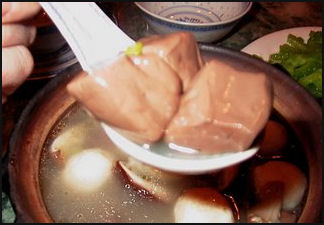
Duck blood Small birds are a common street and snack food. They are skewered, roasted and fried and served on sticks. They are often eaten bones and all between sips of beer in streetside stalls. It is sometimes said these are sparrows but more often than not they are quails. In Beijing, you can get silkworms, grasshoppers, seahorses, and scorpions — with their stingers intact. Other weird food favorites include snakehead soup, duck feet marinated in blood, solidified duck blood, pork lungs, peacock and pig face. The latter is made by pouring hot tar in a pig head to remove the hair put not the skin.
Banquet specialties include cow’s lung soaked in chili sauce, goose stomachs, fish lips with celery, goat’s feet tendons in wheat noodles, shark’s stomach soup, chicken-feet soup, monkey’s head, ox forehead, turtle casserole, pigeon brain, deer ligament and snake venom, lily bulbs and deer’s penis. The Chinese considered many foods eaten by non-Chinese to be strange. They consider eating a plain cooked steak as primitive and unappetizing. Many regard eating cheese or butter as disgusting. It is hard to find cheese in local shops.
Menus offers things like “goat genitals soup,” “pig hoof gruel,” “old vinegar jelly fish,” “fried goose intestines,” “know taste pork meat pie,” “chicken without sexual life,” “pockmarked old-lady’s tofu.” “fish smell like pork.” “spicy ducks heads” and “lover’s lung” — albeit many of these are just weird translations. Some restaurants serve donkey and the entree “Explodes the Stomach, Slides the Tendon and Fires the Sheep’s Internal Organs.”
Some people in China have eaten soil and clay as a "famine food." Analysis of samples of eating soil shows that it contains large amounts of iron, calcium, vanadium, magnesium, manganese and potassium — essential nutrients that are in short supply in times of famine. While this practice was more common in the 1950s when China experienced a severe famine associated with the Great Leap Forward it may still be practiced. In some places in Central Asia pregnant women eat clay, in part to obtain mineral nutrients.
See Separate Articles: RATS AS FOOD IN CHINA factsanddetails.com ; SNAKES AS FOOD IN CHINA factsanddetails.com ; EATING INSECTS IN CHINA factsanddetails.com ; DOGS AND CATS AS FOOD IN CHINA factsanddetails.com ; WILD ANIMALS AND ENDANGERED SPECIES AS FOOD IN CHINA factsanddetails.com ; SHARK FIN SOUP factsanddetails.com ; BEAR PARTS AND CHINESE MEDICINE AND FOOD DELICACIES factsanddetails.com ; PANGOLINS: AND THE CHINESE MEDICINE-FOOD TRADE factsanddetails.com ; ENDANGERED ANIMALS factsanddetails.com; ILLEGAL ANIMAL TRADE factsanddetails.com; ILLEGAL ANIMAL TRADE IN ASIA factsanddetails.com; COMBATING THE ILLEGAL ANIMAL TRADE IN ASIA factsanddetails.com; FOOD IN CHINA: DIET, EATING HABITS AND TRENDS factsanddetails.com ; HISTORY OF FOOD IN CHINA factsanddetails.com CHINESE CUISINE factsanddetails.com ; MEAT IN CHINA factsanddetails.com ; HAIRY CRABS AND SEAFOOD IN CHINA factsanddetails.com ; REGIONAL CHINESE CUISINES factsanddetails.com ; FAMOUS CHINESE FOODS AND DISHES WITH INTERESTING, FUNNY NAMES factsanddetails.com ; BIRD'S NEST SOUP factsanddetails.com DUCKS, DAIRY COWS, FOIE GRASS AND LIVESTOCK IN CHINA factsanddetails.com;
Websites and Sources: Unusual Food photos travel-images.com Wikipedia article Wikipedia ; Good Academic site on regional cuisines kas.ku.edu ; China.org Food Guide china.org ; Travel China Guide travelchinaguide.com Wikipedia article on History of Chinese Food Wikipedia ; Books: “Beyond the Great Wall; Recipes and Travels in the other China” by Jeffrey Alford and Naomi Duguid (Artisan, 2008) features travel stories, political analysis and recipes from Tibet, Xinjiang, Guizhou, Inner Mongolia and other places off the beaten track in China.
RECOMMENDED BOOKS: “Strange Foods: Bush Meat, Bats, and Butterflies: An Epicurean Adventure Around the World” by Jerry Hopkins and Michael Freeman Amazon.com; “Chinese Street Food: Small Bites, Classic Recipes, and Harrowing Tales Across the Middle Kingdom” Amazon.com; “Chinese Snacks: Wei-chuan Cook Book (1974) by Huang Su-Huei Amazon.com; “Invitation to a Banquet: The Story of Chinese Food” by Fuchsia Dunlop Amazon.com; “The Emperor's Feast: A History of China in Twelve Meals” by Jonathan Clements Amazon.com; “To the People, Food Is Heaven: Stories of Food and Life in a Changing China” by Audra Ang, Emily Zeller, et al. Amazon.com; “Stinky Tofu Photo Book: An Awesome Photobook With Beautiful Photos And Cover For Decoration” by Rainbow Joy! Amazon.com; “Shark's Fin and Sichuan Pepper: A Sweet-Sour Memoir of Eating in China” by Fuchsia Dunlop and Bee Wilson Amazon.com
Eating Rooster Blood at a Country Restaurant
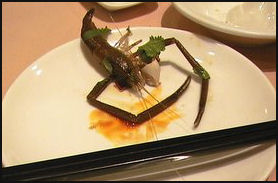
drunken shrimp
David Sedaris wrote in The Guardian, “By the time we headed back down the mountain, it was almost three. Most restaurants had quit serving lunch, so we stopped at what's called a Farming Family Happiness. This is a farmhouse where, if they're in the mood, the people who live there will cook and serve you a meal.” [Source: David Sedaris, The Guardian July 15, 2011]
As far as I know there wasn't a menu. Rather, the family worked at their convenience, with whatever was handy or in season. There was a rooster parading around the backyard and then there just wasn't. After the cook had slit its throat, he used it as the base for five separate dishes, one of which was a dreary soup with two feet, like inverted salad tongs, sticking out of it. Nothing else was nearly as recognisable. I'm used to standard butchering: here's the leg, the breast, etc. At the Farming Family Happiness, rather than being carved, the rooster was senselessly hacked, as if by a blind person, a really angry one with a thing against birds. Portions were reduced to shards, mostly bone, with maybe a scrap of meat attached. These were then combined with cabbage and some kind of hot sauce. Another dish was made entirely of organs, which again had been hacked beyond recognition. The heart was there, the lungs, probably the comb and intestines as well. I don't know why this so disgusted me. If I was a vegetarian, OK, but if you're a meat eater, why draw these arbitrary lines? "I'll eat the thing that filters out toxins but not the thing that sits on top of the head, doing nothing?" And why agree to eat this animal and not that one?
The dishes we had at the Farming Family Happiness were meant to be shared, and as the pretty woman with the broad face brought them to the table, the man across from me beamed and reached for his chopsticks. "You know," he said, "this country might have its ups and downs but it is virtually impossible to get a bad meal here." I didn't say anything. Another of the dishes that day consisted of rooster blood. I'd thought it would be liquid, like V8 juice, but when cooked it coagulated into little pads that had the consistency of tofu. "Not bad," said the girl seated beside me, and I watched as she slid one into her mouth.
Eating Duck Tongues, Turtles and Sea Horses
Turtles have long been associated with longevity and health. Widely consumed in soups and stews, the Chinese believe they provide lots of nutrition and replenish energy. The Chinese fondness for turtle soup and turtle stew has caused turtle population across Asia to decline. In recent years the Chinese have begun importing hundreds of thousands of turtles — mostly softshells and snappers — from the southern United States and now there are worried the large number of wild turtles captured could have disastrous impact on turtle populations there. Soft shell turtle dishes are generally soups made with turtles braised in a brown sauce. There are lots of bones. The jelly-like flesh on the edge or the hard top shell is said to be tasty. The turtle soften come from Lake Hingfu in Hubei Province. The dish became famous when it was revealed that the coach Ma Junren served it to his world-record breaking female runners.
David Sedaris wrote in The Guardian, On our first night in Chengdu, we joined a group of four for dinner — one Chinese woman and three westerners. The restaurant was not fancy, but it was obviously popular. Built into our table was a simmering cauldron of broth, into which we were to add side dishes and cook them until they were done. "I've taken the liberty of ordering us some tofu, some mushrooms and some duck tongues," said the western woman sitting across from me. "Do you trust me to keep ordering, or is there anything in particular you might like?" ...I figured the duck tongues were a sort of test, so I made it a point to look unfazed. Excited even. [Source: David Sedaris, The Guardian July 15, 2011]
When I was eventually forced to eat one, I found that it actually wasn't so bad. The only disconcerting part was the shape, particularly the base, from which dangled tentacle-like roots. This reminded one that the tongues had not been cut off but, rather, yanked out, possibly with pliers. Of course the duck was probably dead by then, wasn't it? It's not as if they'd jerk out the tongue and then let it go, traumatised and quackless but otherwise whole.
“Hugh was right there with me, and though he ate the same thing I did, he practically wept when someone in China mentioned eating sea horses. "Oh, those poor things," he said. "How could you?" I went, "Huh?" It's like eating poultry but taking a moral stand against those chocolate chicks they sell at Easter. "A sea horse is not related to an actual horse," I said. "They're fish, and you eat fish all the time. Are you objecting to this one because of its shape?" He said he couldn't eat sea horses because they were friendly and never did anyone any harm, this as opposed to those devious, bloodthirsty lambs whose legs we so regularly roast with rosemary and new potatoes.
Regional Weird Foods in China
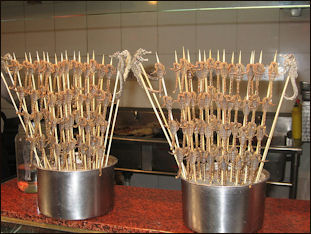
scorpions Hunan dishes include spicy frogs' legs, tripe and sea cucumbers. People from Sichuan eat duck intestines, pig brains, frog's thighs, green bean seeds and rabbit ears. In Qinghai you can find sheep vein, yak vein, caterpillar fungus, a seaweed-like black moss known as "hair grass," and stir-fried camel's foot.
Among the dishes one can find in Harbin are "yellow flower" (chopped lily stalks), grilled bear paw, stewed moose nose with mushrooms, white fungus soup, and monkey-leg mushrooms. In Manchuria, frog oil taken from frog ovaries is often added to soups and stews served at expensive restaurants.
Yunnan favorites include live goat fetus, caterpillar fungus, pseudo-ginseng or gastrodia, three-year cured ham, fried goat cheese, and deep fried bee larvae. Delicacies from Hubei Province include snake meat, venison from spotted deer, soft-shell turtle and crocodile claw. Cobra-bile wine is consumed in Canton. People in Beijing like ant soup.
Some restaurants in southern China serve tiger, dragon and phoenix soup with cat for tiger, snake for dragon and chicken for phoenix. The mix is said to have more health benefits than the benefits associated with each individual animal. Chinese also eat horse sausages and kittens. Huangshan Stone Frog is a speciality of Anhui province. The black-skinned frogs found there are quite large and bear quite a bit of meat. The meat is said to have a light, sweet flavor. Frog fat is enjoyed as a desert. Eating frog is supposed to strengthen your bones and improve your eyesight.
Weird fish and seafood dishes include fish lips and eyeballs and drunken shrimp, a delicacy in which live shrimp are dipped in alcohol, and their head is pinched off and eaten. Sweet-and-sour Yellow River fish is cooked while it is still alive and served while still breathing. Jellyfish is squeeze dried, processed with diluted acid and the dried in the sun. It can be kept for months without spoiling. Not all jellyfish can be eaten. Some lack the texture to be appetizing when dried.
Thousand-year-old eggs, a Guangdong delicacy, are made from duck eggs coated with lime, ashes and mud and soaked in a briny liquid for 100 days until the yolks turns green and the whites become gelatinous and dark brown. Some say they are soaked in horse urine; others say this is an urban myth. The eggs have a creamy, cheese-like flavor and a strong smell. Some are aged in black mud. These become partially hardened and are sold in markets as a seasoning for pork products. Thousand-year-old eggs are often served with rice congee or cut in chunks and eaten with slices of pickled ginger to soften the taste. Chinese also eat duck eggs that are packed in a pot and buried in the ground. In some parts of China eating snails is as common as it is France.
Human-Derived Health Food in China
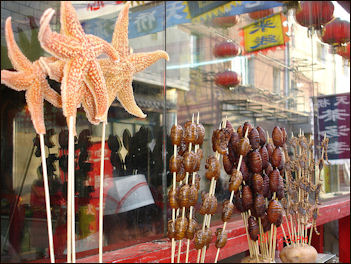
In 1995, a Hong Kong-based magazine reported that women in China were taking a tonic made from human fetuses which promised to "make the skin smoother, the body stronger, and is good for the kidneys." The fetuses, which were typically a few months old and were the result of abortions, were given away free of charge by the Shenzhen Health Center for Women. A doctor at another clinic told the magazine that fetuses with pork soup were especially good.
Chinese believe that human milk can cure many ailments. During the Yangtze River floods of 1998, soldiers rubbed their bodies with breast milk and drank cups of it given to them by wet nurses.
In 1991, Reuters ran a story about a pair of brothers who took the buttocks and thigh meat from cadavers about to be cremated and used them to make Sichuan-style dumplings at White Temple restaurant on Hainan Island. The story turned out to be a hoax. Neither the brothers nor the restaurant existed.
Human Placenta-Eating in China
Reporting from Shanghai, Bill Savadove of AFP wrote: After Wang Lan delivered, she brought home a baby girl and her placenta, which she plans to eat in a soup – adopting an age-old practice in Chinese traditional medicine. The health-giving qualities of placenta are currently creating a buzz in Western countries, where some believe it can help ward off postnatal depression, improve breast milk supply and boost energy levels. But placentophagy – the practice of eating one’s placenta after birth – is relatively common in China, where it is thought to have anti-ageing properties, and dates back more than 2,000 years. “It is in the refrigerator now and I am waiting for my mother to come and cook it to eat. After cleaning, it can be stewed for soup, without that fishy smell,” Wang said, adding she believed it would help her recover from delivery. [Source: Bill Savadove, AFP, June 25, 2012 /*]
“Qin Shihuang, the first emperor of a unified China, is said to have designated placenta as having health properties some 2,200 years ago, and during China’s last dynasty, the dowager empress Cixi was said to have eaten it to stay young. A classic medical text from the Ming Dynasty (1368-1644) said placenta – which lines the uterus and is key to the survival of the foetus – was “heavily nutritious” and “if taken for the longer term… longevity will be achieved”. /*\
“China’s state media says the practice of eating placenta has re-emerged over the past decade. One maternity hospital in the eastern city of Nanjing reported that about 10 percent of new parents took their placenta after childbirth. Internet postings swap recipes on how to prepare placenta. One popular health website suggests soup, dumplings, meat balls or mixing it with other kinds of traditional Chinese medicine. While trade in the organs has been banned since 2005, pills containing placentas ground into powder are legally available in Chinese pharmacies – indicating unwanted placenta is somehow making its way to drug companies. /*\

bugs and maggots from Yunnan
““It is a tonic to fortify the ‘qi’ and enrich the blood,” a traditional medicine doctor at Shanghai’s Lei Yun Shang pharmacy said, referring to the “life force” that practitioners believe flows through the body. “Sales are very good. Basically, every time we have supplies, they sell out very quickly,” a clerk at the shop told AFP. And it’s not just mothers who want to eat the placenta. One new father in Shanghai who did not want to be named said his relatives were eager to try the sought-after item. “My wife and I were still in the hospital… and they ate it,” he said. /*\
“But strong demand has created a thriving black market with hospitals, medical workers and even mothers selling placentas in violation of the law.” In 2011, “authorities investigated a hospital in the southern city of Guangzhou for selling placentas for 20 yuan ($2) apiece. “They (nurses) take the money and use it to buy breakfast,” a source told a the local Xin Kuai newspaper. They fetch a higher price in other parts of China like the eastern city of Jinan, where dealers ask as much as 300 yuan per placenta, most sourced from hospitals, the Jinan Times said last year.”/*\
In May 2012, “South Korean customs said they had uncovered multiple attempts to illegally import over 17,000 capsules apparently containing the powdered flesh of dead babies.
Experts have said the pills may actually be made from human placenta, raising concerns that China’s trade in the organs has started to go international. Some people, meanwhile, are averse to the idea of eating the organ. “I know it’s good for health, but the idea of eating human flesh is just disgusting. I cannot do it,” said Shanghai accountant Grace Jiang, who opted to leave the placenta after giving birth to her son.” /*\
Human Breast Milk Popular Drink among Shenzhen Rich
In July 2013, Chris Luo wrote in the South China Morning Post, “While many Chinese parents continue to struggle to find safe and trusted milk powder for their babies, some in Shenzhen are paying to enjoy a new “nourishment” – human breast milk – and a few of them are doing so by breast feeding, according to Chinese media. Increasing numbers of adults have been hiring wet nurses so they can consume breast milk for its nutritional value, Lin Jun, a manager of Xinxinyu Household Service Company in the southern city of Guangdong, told the Southern Metropolis Daily . Lin went on to say that his company is promoting and expanding its breast milk supply business from babies to adults, the newspaper reported. [Source: Chris Luo, South China Morning Post, July 2, 2013 **]
“Clients can choose to consume breast milk directly through breastfeeding … but they can always drink it from a breast pump if they feel uncomfortable,” the paper quoted Lin as saying. He claimed breast milk was now popular among adults with high incomes and high-pressure jobs and who suffered from poor health. “Quite a few of our clients hire in-house wet nurses to ensure a supply of fresh breast milk on a daily base,” Lin said in the report, adding “wet nurses rarely raise objections as long as the price is right.” **

Chinglish
“A spokesperson for the company who refused to be identified claimed the report was entirely false, insisting his company’s household services did not include recommending wet nurses. The allegations were malicious gossip aimed at driving his company out of business, he told the South China Morning Post. However, Xinxinyu Household Service Company’s advertisements can be seen on a number of marketing websites, promoting the high quality services of its wet nurses, as well as its nannies, stewards, confinement nurses and tutors. The advertisements state that the company’s wet nurses can provide services to adults in poor health. Photos online show wet nurses and staff with what appear to be company logos on the walls. **
“According to the newspaper report, a wet nurse who provides breast milk to adults can earn an average monthly wage of 16,000 yuan (HK$20,238). A healthy and attractive wet nurse can earn even more, the paper was told. The claims seem to be supported by adverts placed by Xinxinyu on at least one recruitment website for positions of wet nurses with monthly salaries of between 12,000 to 20,000 yuan. “Consuming human breast milk is quite popular among my social circle … spending 10,000 to 20,000 yuan hiring a wet nurse is not uncommon at all,” Southern Metropolis Daily also quoted an anonymous client as saying, “although only a few people would suck breast milk directly from a wet nurses’ nipples.” **
“The anonymous client said he paid 15,000 yuan to a wet nurse and had her live at his home for a month, according to the report. Legal experts have warned that the practice may be a form of sexual service. “There is an essential difference between sucking on a breast and drinking from a pump, as the former largely exceeds the necessity of diet,” Guangdong lawyer Mei Chunlai said. But Shenzhen police told the paper that it would be difficult to prove if the act was a sex crime as it was hard to acquire evidence. **
Urine Consumption in China
Chris Buckley of the New York Times wrote: “If imbibing urine is not your cup of tea, People’s Daily — the solemn voice of the Chinese Communist Party — is with you on that one. On Friday, the newspaper took time off from its usual encomiums to party leaders to warn people against drinking their own pee. “There is no clinical or medical basis for using urine over a long period of time as a product for preventing and curing illness, or as a health supplement,” an investigative report in the paper said, citing squadrons of medical experts. [Source: Chris Buckley, Sinosphere blog, New York Times, June 27, 2014 ***]
“These days, the party’s main newspaper rarely takes on a problem without finding a plotter behind the scenes. And so it was here. The report said the dubious practice had been encouraged by the China Urine Therapy Association, which it found plenty to be displeased about. The report alleged that the Hong Kong-registered association lacked the right credentials to qualify as a nonprofit group. The sleuthing reporter tracked down the website of the China Urine Therapy Association and found grounds for suspicion there as well. “After visiting the physical address for the website, it was found to be in an old residential neighborhood of Nankai District in Tianjin,” a port city near Beijing, the report said. “There was an old man inside, and he had nothing to do with urine therapy.” ***

Chinglish
“Yet to judge by the association’s website and recent Chinese news reports, there is no lack of old men convinced that regularly drinking one’s own urine is a big plus health-wise. Urine therapy, or urotherapy, has a long history and numbers of adherents in many countries, although medical experts say it has no detectable benefits. Try telling that to the Chinese association. The website says its “objective and task is to propagate our country’s ancient culture of imbibing urine, integrating with modern science and technology to put into practice ‘I drink my urine to heal my body’ and ‘I drink my body to cure my disease,’ ” it says. “This is opening a door to health that money cannot buy.” ***
“The urine association belongs to an undergrowth of less-than-orthodox medical movements and beliefs that persist in China, often citing roots in ancient tradition, despite official skepticism and denigration. People’s Daily may have been prompted to move against urine drinkers by a recent burst of publicity for their cause. In news reports that spread on the Internet in China, elderly Chinese men have boasted of the benefits of the habit and demonstrated its pleasures in pictures that may cause some readers to wince. ***
“One man in his late 70s told a newspaper in the southwestern city of Chongqing that the therapy took some getting used to, but gulping down the liquid was not as unpleasant as many assumed. “At least, it’s a lot better tasting than many bitter Chinese medicines,” he Said. But he recommended using a glass, not plastic cup, to preserve “the authentic taste” of the liquid. For reasons that the report did not explain, he insisted on using a false name.” ***
Yellow Noodles with Donkey Meat
Donkey meat is a popular snack in some areas of China, although it only accounts for a tiny fraction of overall meat consumption. In 2011 China slaughtered 2.4 million donkeys, according to country's livestock industry yearbook. [Source: Adam Jourdan, Reuters, January 2, 2014 |~|]
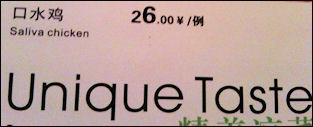
Chinglish, See
English article for more
Reporting from the Silk Road town Dunhuang in Gansu Province, Takahiro Suzuki wrote in the Japan News, “Huangmian, or yellow noodles, a traditional dish in northwestern China, could be mistaken at first glance for pasta thanks to their colour and thickness Dunhuang, in Gansu Province, prospered as an oasis city on the Silk Road and is famous for huangmian topped with sauce flavored with donkey meat, a local delicacy. At Dunhuang Night Market in the commercial district at the heart of the city, restaurants offering the local specialty stand side by side. This reporter chose an eatery by the name of "Dangji Donkey Meat Yellow Noodle" from among the many options to sample the local fare. [Source: Takahiro Suzuki, Japan News/Asia News Network, April 15, 2014]
“The yellow noodles, which are firmer than the white noodles commonly prepared in China, are topped with a sauce made from donkey meat stir fried with tofu and mushrooms and seasoned with doubanjiang bean chili paste. After my food arrived, I mixed the sauce into the noodles and started to eat, and quickly found myself unable to stop. "In heaven, there is dragon meat, on earth there is donkey meat," 38-year-old restaurant employee, Dang Yanyao, told me, sharing a Chinese saying that sings the praises of donkey meat. The way the sauce perfectly matches the signature noodles is part of the dish's secret and makes it even more delicious. “ .
Image Sources: Weird Meat blog except skinning the snake, Perrechon, Wiki Commons and rat restaurant Asia Obscura ; YouTube
Text Sources: New York Times, Washington Post, Los Angeles Times, Times of London, National Geographic, The New Yorker, Time, Newsweek, Reuters, AP, Lonely Planet Guides, Compton’s Encyclopedia and various books and other publications.
Last updated October 2021
